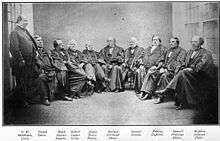List of Justices of the Supreme Court of the United States by court composition
| This article is part of the series on the |
| United States Supreme Court |
|---|
 |
| The Court |
| Current membership |
| All members |
|
| Court functionaries |
|
In order to become a Justice on the Supreme Court of the United States, an individual must be nominated by the President of the United States and approved by the U.S. Senate, with at least half of that body approving in the affirmative (assuming that the Vice President, in his capacity as President of the Senate, is in the chair and votes for the nominee). Generally, a justice's qualifications are judged by the President and, most visibly, by a Senate hearing. There is no definitive qualification of age or experience that is a standard to be met; instead, there is a much more subjective process taken by the Senate, occasionally resulting in a sometimes controversial defeat of judicial nominees.
Congress is responsible for setting the number of justices. With the Judiciary Act of 1789, the Supreme Court was established with six members. The Seventh Circuit Act increased their number by one in 1807, and the Eighth and Ninth Circuit Act set the court's size at nine in 1837. The 1866 Tenth Circuit Act add one more justice. However, the Judicial Circuits Act of 1866 eliminated the seat then vacant after the death of John Catron, and provided that two more would be eliminated as they became vacant. One more was eliminated at the death of James Moore Wayne in 1867, leaving the court with eight justices. The Judiciary Act of 1869 prevented the eighth seat from being eliminated and created one additional seat by setting the total number of seats at nine, where it has stood ever since.
Note that associate justices are listed, from left to right, in order of seniority.
| | |||||||||||||||||||||||||||||||||||||||||||||||||||||||||||||||||||||||||||||||||||||||||||||||||||||||||||||||||||||||||||||||||||||||||||||||||||||||||||||||||||||||||||||||||||||||||||||||||||||||||||||||||||||||||||||||||||||||||||||||||||||||||||||||||||||||||||||||||
|---|---|---|---|---|---|---|---|---|---|---|---|---|---|---|---|---|---|---|---|---|---|---|---|---|---|---|---|---|---|---|---|---|---|---|---|---|---|---|---|---|---|---|---|---|---|---|---|---|---|---|---|---|---|---|---|---|---|---|---|---|---|---|---|---|---|---|---|---|---|---|---|---|---|---|---|---|---|---|---|---|---|---|---|---|---|---|---|---|---|---|---|---|---|---|---|---|---|---|---|---|---|---|---|---|---|---|---|---|---|---|---|---|---|---|---|---|---|---|---|---|---|---|---|---|---|---|---|---|---|---|---|---|---|---|---|---|---|---|---|---|---|---|---|---|---|---|---|---|---|---|---|---|---|---|---|---|---|---|---|---|---|---|---|---|---|---|---|---|---|---|---|---|---|---|---|---|---|---|---|---|---|---|---|---|---|---|---|---|---|---|---|---|---|---|---|---|---|---|---|---|---|---|---|---|---|---|---|---|---|---|---|---|---|---|---|---|---|---|---|---|---|---|---|---|---|---|---|---|---|---|---|---|---|---|---|---|---|---|---|---|---|---|---|---|---|---|---|---|---|---|---|---|---|---|---|---|---|---|---|---|---|---|---|---|---|---|---|---|---|---|---|---|---|
|
 | ||||||||||||||||||||||||||||||||||||||||||||||||||||||||||||||||||||||||||||||||||||||||||||||||||||||||||||||||||||||||||||||||||||||||||||||||||||||||||||||||||||||||||||||||||||||||||||||||||||||||||||||||||||||||||||||||||||||||||||||||||||||||||||||||||||||||||||||||
See also

References
- "Members of the Supreme Court from the Supreme Court of the United States" (PDF). Official website of the Supreme Court of the United States. Retrieved May 29, 2005.